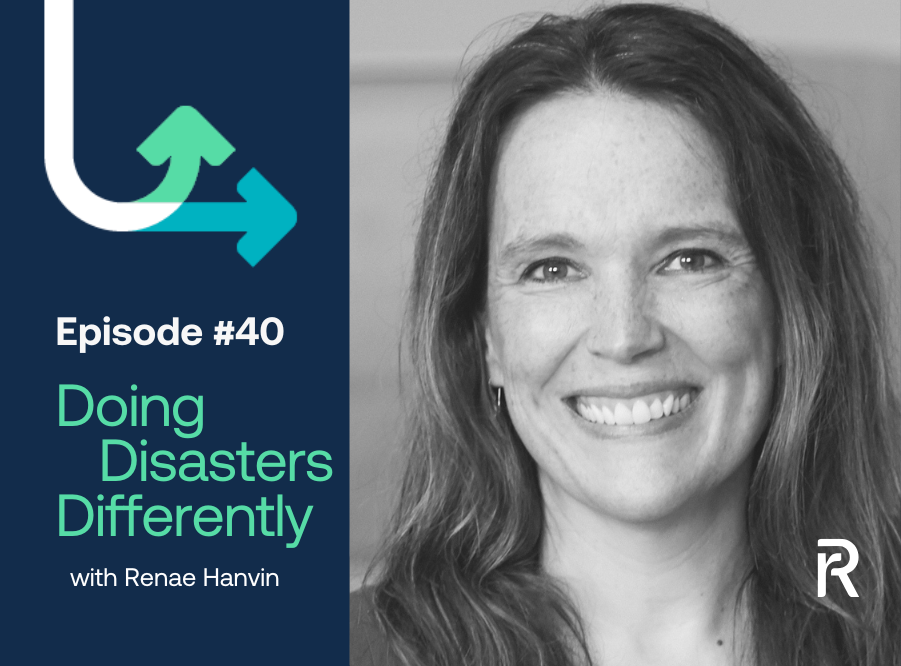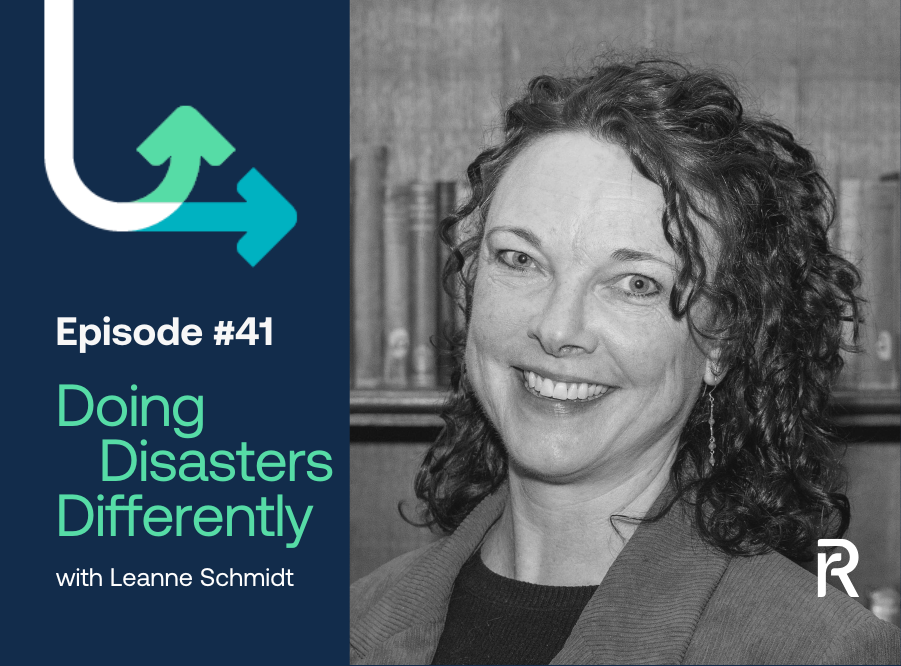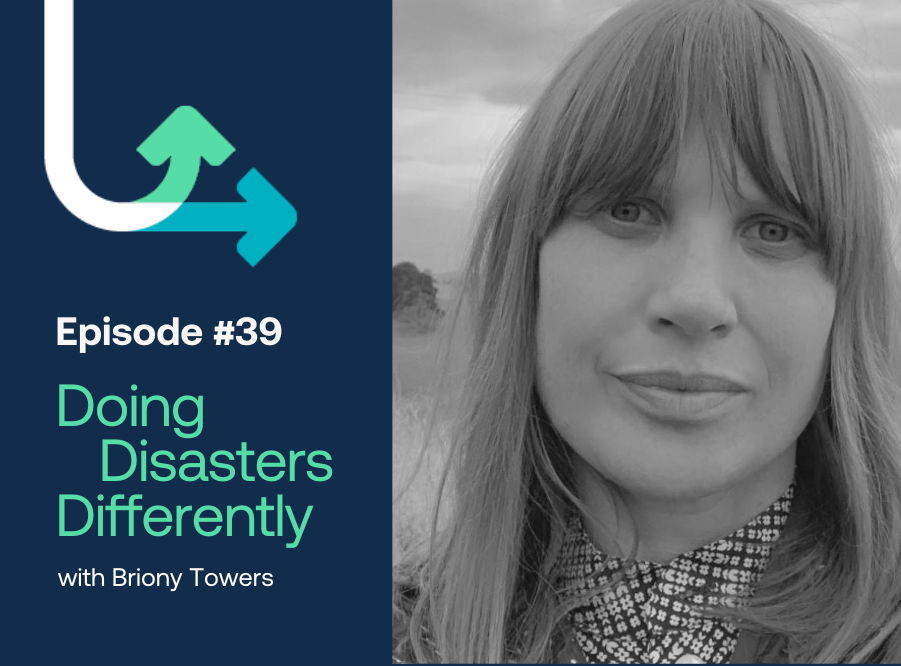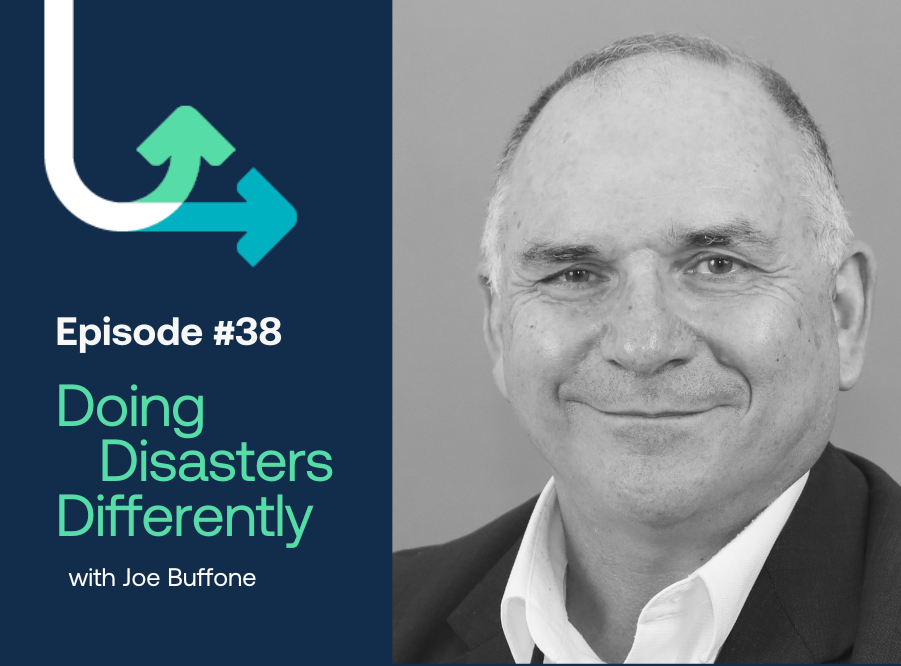
Podcast / Episode #40
Episode #40: What 2 things are we doing differently?
By renae hanvin
Apr 30 2025
This episode
In this special 40th episode of Doing Disasters Differently, Renae reflects on standout conversations from the last ten episodes with thought leaders in disaster resilience. Renae highlights the growing momentum around social capital, the importance of shared responsibility, and how Resilient Ready is translating policy and research into action for communities and small businesses across Australia.
key moments from the conversation
Renae Hanvin is a disaster resilience expert committed to building resilient businesses, helping communities thrive and leading collaborations.
As the CEO + Founder of Resilient Ready, a certified social enterprise, Renae is driving a new ecosystem in business and community risk reduction and resilience.
Renae is leading a new culture of everyday risk reduction, preparedness, resilience and social capital solutions to transform business communities across Australia and beyond.
Renae is a strategist, networker, speaker and trained facilitator. She hosts the ‘Doing Disasters Differently’ podcast and participates on several disaster-related advisory committees.
Renae Hanvin
Hello and welcome to Episode 40. In every 10th episode, I like to do a little bit of a recap in terms of some of the people I’ve been talking to and also some of the key things that are happening in the disaster resilience space. So, oh my gosh, the past 10 episodes of the people I’ve been speaking to, everyone from Professor Daniel Aldrich on Social Capital and what we’re doing in Australia, Dr. Val Ingham on talking about fatigue, Johanna Garnett and cultural heritage, Fiona Jago, her lived experience that she’s delivering around the country for Resilient Ready, Kruthika who moved from India to Australia because of this podcast, Professor Paul Arbon talking about the work we’ve been doing in the grape and wine sector in South Australia. The passionate and hilarious, honorable Bruce Billson, who’s the small and family business ombudsman talking about it’s really time we need to focus on small business.
I talked with Joe Buffone, the Deputy Coordinator General at NEMA about their NEMS stockpile and also Briony Towers, who is a researcher focusing on kids and youth and schools. Wow, what a lineup of amazing conversations. So, today I thought I’d talk about, I guess, two things that I think we are driving at Resilient Ready to be done differently in the disaster space.
Renae Hanvin
As you know, I always like to ask my guests two questions at the end, or sorry, the question at the end. What are the two things you’d like to be done differently? So this time I thought let’s me chat about a couple of things that we are doing that’s a bit different. So those of you who know me know I really like, and I’m a massive supporter of the 2011 National Strategy for Disaster Resilience. I like it because it puts focus on the fact that, it’s a shared responsibility.
We all have a role to play, but I often say that we have a role, but the roles are and need to be different. And I guess we don’t necessarily define what those roles are, but I think those roles are and need to be different. So I’m gonna give you an example about the difference of the role of government and the role of small businesses. So it’s been really awesome to collaborate with the Reconstruction Authority in New South Wales. They’re the state government, entity to create some best outcomes for the impacted communities and small businesses in the Northern Rivers New South Wales region. So we are working with the government, and, you know, government has a role to talk government and small businesses or the likes of Resilient Ready. I think it’s really important to recognize that our role is about connecting with small businesses.
So what and how we say things to small businesses from the voice of Resilient Ready is really different to how government would talk to small businesses. And again, we all have a role and there’s different, different messaging to be played. But when I give you an example, we’ve recently delivered some information sessions up in the Northern Rivers, which were unfortunately, postponed or impacted a little bit by the recent tropical Cyclone Alfred. But in those sessions, it was a great example of government and us as a social enterprise coming together to share information. So government talked about their climate adaptation plans and the strategic focus, et cetera. Really important information coming from government. But what we then talk about is small business people to small business people. And an example is Kylie from a Richmond Valley Mushroom Farm. She came to an information session and she heard Fiona Jago, who’s from Resilient Ready.
Those of you who’ve listened to, her podcast knows that Fiona joined Resilient Ready after I worked with Kangaroo Island and the businesses for a couple of years. And she goes out and delivers, workshops about her lived experience of being greatly impacted as a caravan park owner on Kangaroo Island. So we had these information sessions and Kylie heard Fiona talk about her experiences of the bushfires on Kangaroo Island in 2019 and 2020, where her car, Fiona’s business was really impacted. So Kylie also had a major devastation from her business in Lismore because of the floods a few years ago. And like Fiona, she pretty much lost all of her business in terms of her operations from the disaster. Now, Kylie, like Fiona decided to rebuild and it’s been such a long stretch since the floods, but she’s doing it and it’s, it’s rebuilding better than ever.
And when she heard Fiona share her story at the information session, she went home to her husband and she said, you know what? If she can do it, we can do it. And I think that’s the power in what we do at Resilient Ready. We translate government policy and academic research and we really just connect it in that peer-to-peer way, business person to business person. And as you know, we work with corporates and we also work with small businesses. So I think our role in building resilience and our role as part of that shared responsibility is to translate government and academic research into language and behaviors that the amazing people behind small businesses and not-for-profits and corporates can understand. So they can think different, but we also then show them how they can do different. So very much a part of what we do is led by nudge theory and micro learning because again, I go back to the, I guess the differences between, you know, state governments and us as small business, a social enterprise.
Like state governments have big policies and documents and you know, frameworks they have to create, which are really, really important, but they don’t always talk to or can’t really easily translate to small businesses. I guess a bit like the insurance sector as well. Insurance policies are very complex and don’t also translate to businesses. But what we do through our business community resilience programs and like the Business Beyond Disasters, one we’re delivering in the Northern Rivers is we translate it, we translate it into the words, the pictures, the videos, the information that we can share with the people behind small businesses and nonprofits. So then they can know what their role is too, and they can take on and own their shared responsibility. I really love collaborating with all types of stakeholders, but I think it’s really important when we do that collaboration that we enable each of the stakeholder groups to be who they are.
So we support each other to, I guess as part of the ecosystem, communicate the information to the different stakeholder groups. And that’s where the information that governments want, that academia wants, that not-for-profits, wants that, you know, like us business and corporates wants, that’s where we’re gonna get the best outcome of shared responsibility. I think, you know, it’s, it’s fair to say and you know, I’m not trying to be controversial, but government can’t connect with small business people. Like small business people can connect with small business people. And I think that’s where, perhaps, you know, a better education and acceptance across the sector is gonna really bring great benefits to outcomes. But I have to say, us collaborating with New South Wales Reconstruction Authority to create a business beyond disasters version of our BCR toolkit has been a really great example of where each entity has kind of tweaked and worked together to come to a really good outcome so that we can each create and lead and drive what’s in the best interests for those businesses and not-for-profits in the Northern Rivers regions.
And we’ve worked with many, many communities around Australia, including Kangaroo Island and the Blue Mountains and the farming communities across Northern New South Wales communities across South Australia and, you know, high risk areas of, Victoria and even up in Queensland as well to really enable, I guess those people behind the businesses and non-profits to get what they need out of the government policies as well. So I guess if I can ask people listening today who might be from government or councils or, other entities as such to think differently about the role we can play as a small business entity to really translate what you are trying to say right directly to the key stakeholder groups like those in small businesses. ’cause I mean, that’s what we exist for, that’s what we are here for now. The, the second thing I just wanted to share about and talk about is how excited I am about the increasing momentum of social capital and social infrastructure in Australia.
Now, pretty much everyone who knows me knows that I’m so passionate and has been a really important part of Resilient Ready in the sense that when we focus on building, business community resilience, it’s about the business sustainability. We want businesses to stay in business. It’s about the emergency management and disaster preparedness. We wanna teach them and connect them into emergency services and get them doing things so that they reduce their risks, et cetera. But it’s also about the social capital because connections are, in my mind, the foundations of resilience and people in businesses and not-profits in communities are the untapped golden assets and nuggets of fostering and facilitating connections. And those places that they’re in, like the pubs or the libraries or the cafes, or as Professor Aldrich likes to say, it’s probably more an American thing. The karaoke bars, it’s so important that we think differently about the role that those, places that foster connection play and the people who can foster connections, what role they have and how we can think differently and invest in them.
Now, last year we had Professor Aldrich over and we delivered the South Australian snapshot. And again, big recognition to SAFECOM and Miriam Lumb and Johanna Garnett in terms of, looking at our proposal and thinking about, you know, let’s do that as a pilot in South Australia because the forum that we had, which had about 75 people, we had to hire in plastic chairs ’cause we didn’t have enough chairs. the findings from that I think really articulated that social capital and social infrastructure measurement and then strategic investment is kind of a missing piece of the puzzle. So we’ve got all the other risk layers, but we really don’t have, I guess that as a component of how we look at communities in terms of whether they are resilient and ready or if they have high levels of vulnerability. So we recently won the Disaster Ready Fund Round Two project, which we are so grateful for the South Australian government and, the Australian government through NEMA to be considering of our proposal.
So as I share this, we’re actively delivering, this pilot project, which is to create a national framework on social capital and social infrastructure. And what that means is that we’re gonna be creating a, I guess, unified Australian definition for what they each are and look at the categories as to how we’re gonna measure it. So we are working with a really wonderful organisation called CARA and Dean and Neil and Marcus are awesome. They are from the Center for Australian Research into Access (CARA), and that’s part of Deakin Rural Health. And what this will be doing is as part of our pilot data measurement in the three South Australian communities, which is Adelaide City, Whyalla and Kangaroo Island, we are gonna be introducing groundbreaking data research and data mapping into it. So if you think about the project that I’m leading at Resilient Ready, it’s about Professor Daniel Aldrich’s global research on social capital and social infrastructure, which most of us know about.
And then it’s this data mapping that is even Professor Aldrich was like, holy moly, that’s like a totally different way of thinking about it, which is so exciting. So the data and the team at CARA as well. So it’s a really awesome, I think collaboration between Resilient Ready social enterprise, CARA, a research academia, and also Professor Aldrich so that we can create and pilot. So we’re gonna create the national framework, so we have the document to understand, what social capital is. And then we also have online tool will be the end result where we can map and again, share the pilot mapping, of those three South Australian communities. It’s so exciting for me and I’m hoping for you and those listening too, that we are really taking, you know, big steps forward in terms of recognizing the really, really important, role that social capital and social infrastructure can play in building resilience in Australia.
And look, in a perfect world, we’d be able to scale it up and do all of Australia. So crossing fingers and toes that that might be possible in the future. But again, I’m so excited about how people are thinking differently and they’re approaching me, about, you know, they’re, they’re looking differently at, at Social Capital. I was talking to Dr. Briony Towers the other day, I did obviously a podcast with her and she’s like, oh my gosh, I’ve never thought of schools and youth in this way. And look, we’re already doing this and now I wanna research and do more. And that’s what we want. So if you are doing anything or if you know of any policies or frameworks or metrics or data around how you know, we can recognize and define and measure social capital and social infrastructure, please reach out to us at [email protected] because we are really, really open to making this a really collaborative, outcome, from next month, which would be May in May and June.
Professor Aldrich and I are visiting every state and territory across Australia. We’ll be in Adelaide, Perth and Fremantle, Darwin, Sydney, Canberra, Melbourne, Brisbane and Hobart because we’re gonna sit down and really talk about what social capital and social infrastructure means to each state and territory across Australia. Because it’s, while the pilot project is focused on some South Australian communities, it’s an absolute, absolute no brainer in my eyes that when we create the national strategy, it has to be inclusive of what everyone wants and thinks it should be. and in saying that the pilot data that we are gonna be pulling for South Australia is gonna be national ready. So we don’t wanna pull out data in South Australia for those three communities. That’s only gonna be beneficial for South Australia. The way we’re gonna pull out the data by the end of 2025 is so that it’s relevant to every state and territory should we get funding and be able to scale up, the amazing work that we are doing. So I think again, just a little bit of a reflection in terms of the two things, that I think are changing and I think are pretty exciting to be doing differently in the disaster space. So thanks so much for listening to my podcasts. I, yeah, I don’t really recognise, I think that, so many people are listening and I’m hoping it makes you think a little bit differently and do things differently about that you, the role that you play in shared responsibility, in the disaster space too.



